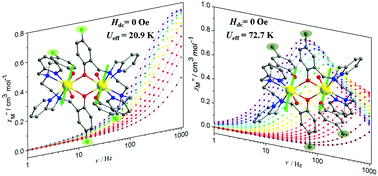Enhancing single-molecule magnet behaviour through decorating terminal ligands in Dy2 compounds†
Abstract
The utilization of two isomorphic ligands with different substituents leads to two centrosymmetric DyIII dimers, namely, [Dy2(bfbpen)2(H2O)2]·2I− (1) and [Dy2(bcbpen)2(H2O)2]·2I−·0.5H2O (2) (H2bfbpen = N,N′-bis-(2-hydroxy-5-fluoro-benzyl)-N,N′-bis-(pyridin-2-ylmethyl)ethylenediamine and H2bcbpen = N,N′-bis-(2-hydroxy-5-chloro-benzyl)-N,N′-bis-(pyridin-2-ylmethyl)ethylenediamine). Although Dy ions in both compounds uniformly exhibit a square-antiprism geometry, the critical difference found in the terminal substituents of the two ligands fine-tunes the local crystal field around Dy centers and the dinuclear molecular structures of 1 and 2. Magnetic investigations unveil that both 1 and 2 display dynamic magnetic relaxation of single-molecule magnet (SMM) behaviour with different energy barriers of 20.9 K for 1 and 72.7 K for 2 under a zero direct-current (dc) field, as well as 26.9 K for 1 under a 1200 Oe dc field. Compared to 1, the stronger uniaxial anisotropy and magnetic exchange in 2 render it a better SMM as evidenced by the higher energy barrier. Ab initio calculations are also performed on both Dy2 compounds to rationalize the observed discrepancy in their magnetic behaviours. The contribution illustrates that the SMM behaviour could be effectively enhanced by means of deliberate local structural manipulation.



 Please wait while we load your content...
Please wait while we load your content...